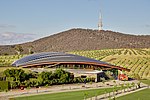Scrivener Dam
Buildings and structures in CanberraDams completed in 1963Dams in the Australian Capital TerritoryGravity damsMurray-Darling basin ... and 1 more
Use Australian English from February 2013

Scrivener Dam is a concrete gravity dam that impounds the Molonglo River in Canberra, Australian Capital Territory. The dam creates Lake Burley Griffin, which was established for recreational and ornamental purposes. Named in honour of surveyor Charles Scrivener, the dam was officially inaugurated on 20 September 1963 (1963-09-20) and the official filling of the lake commemorated on 17 October 1964 (1964-10-17) by the Prime Minister, Robert Menzies. The dam wall is located on Lady Denman Drive and is adjacent to the National Zoo & Aquarium and a viewing area for the official residence of the Governor-General of Australia.
Excerpt from the Wikipedia article Scrivener Dam (License: CC BY-SA 3.0, Authors, Images).Scrivener Dam
Lady Denman Drive, Canberra Yarralumla
Geographical coordinates (GPS) Address Nearby Places Show on map
Geographical coordinates (GPS)
| Latitude | Longitude |
|---|---|
| N -35.299722222222 ° | E 149.07222222222 ° |
Address
Lady Denman Drive
Lady Denman Drive
2600 Canberra, Yarralumla
Australia
Open on Google Maps






